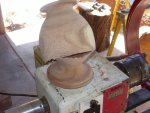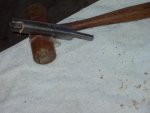Dan Mosley
Member
- Messages
- 1,169
- Location
- Palm Springs, Ca
Had a few hours free this morning and decided to keep trying out my new toy (Monster Hollowing Rig). Chucked up a log of mesquite and started shaping the exterior. When that was done i set up my steady rest and began end grain hollowing the vessel. I had it fairly well hollowed out but i cut thru the side wall and blew it apart. After alot of bad words I thought about what went wrong. I think i should have checked the laser more often and adjusted it more frequently to the cutting edge. I think i was having to much fun hollowing and just blew off checking and adjusting as we discussed in prior threads.
Last picture was from the previous turning and when i took the tool out I noticed that i had bent the shaft on the tool holder. I took it to my vice and bent it back. Not real sure how or when it happened but im glad i could bend it back easy and didn't break it........hummm still alot more learing i see.
Well tomm is another day and im hoping for another chance.
Last picture was from the previous turning and when i took the tool out I noticed that i had bent the shaft on the tool holder. I took it to my vice and bent it back. Not real sure how or when it happened but im glad i could bend it back easy and didn't break it........hummm still alot more learing i see.
Well tomm is another day and im hoping for another chance.
Attachments
Last edited:





 We've all had it happen...you have the right attitude...tommorrow is another day and you can learn from mistakes.
We've all had it happen...you have the right attitude...tommorrow is another day and you can learn from mistakes. 